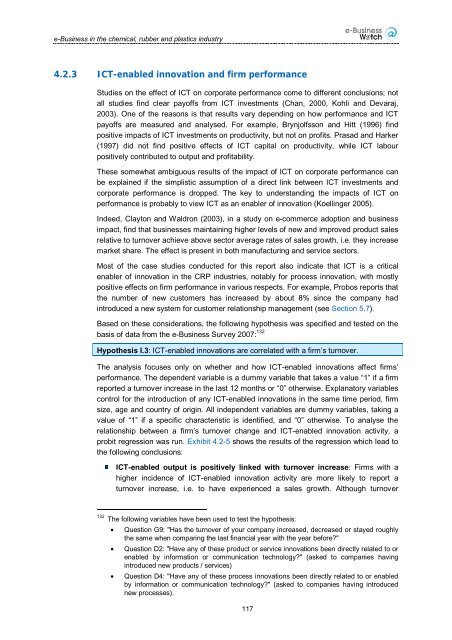Downloads - empirica
Downloads - empirica
Downloads - empirica
You also want an ePaper? Increase the reach of your titles
YUMPU automatically turns print PDFs into web optimized ePapers that Google loves.
e-Business in the chemical, rubber and plastics industry4.2.3 ICT-enabled innovation and firm performanceStudies on the effect of ICT on corporate performance come to different conclusions; notall studies find clear payoffs from ICT investments (Chan, 2000, Kohli and Devaraj,2003). One of the reasons is that results vary depending on how performance and ICTpayoffs are measured and analysed. For example, Brynjolfsson and Hitt (1996) findpositive impacts of ICT investments on productivity, but not on profits. Prasad and Harker(1997) did not find positive effects of ICT capital on productivity, while ICT labourpositively contributed to output and profitability.These somewhat ambiguous results of the impact of ICT on corporate performance canbe explained if the simplistic assumption of a direct link between ICT investments andcorporate performance is dropped. The key to understanding the impacts of ICT onperformance is probably to view ICT as an enabler of innovation (Koellinger 2005).Indeed, Clayton and Waldron (2003), in a study on e-commerce adoption and businessimpact, find that businesses maintaining higher levels of new and improved product salesrelative to turnover achieve above sector average rates of sales growth, i.e. they increasemarket share. The effect is present in both manufacturing and service sectors.Most of the case studies conducted for this report also indicate that ICT is a criticalenabler of innovation in the CRP industries, notably for process innovation, with mostlypositive effects on firm performance in various respects. For example, Probos reports thatthe number of new customers has increased by about 8% since the company hadintroduced a new system for customer relationship management (see Section 5.7).Based on these considerations, the following hypothesis was specified and tested on thebasis of data from the e-Business Survey 2007: 132Hypothesis I.3: ICT-enabled innovations are correlated with a firm’s turnover.The analysis focuses only on whether and how ICT-enabled innovations affect firms’performance. The dependent variable is a dummy variable that takes a value “1” if a firmreported a turnover increase in the last 12 months or “0” otherwise. Explanatory variablescontrol for the introduction of any ICT-enabled innovations in the same time period, firmsize, age and country of origin. All independent variables are dummy variables, taking avalue of “1” if a specific characteristic is identified, and “0” otherwise. To analyse therelationship between a firm’s turnover change and ICT-enabled innovation activity, aprobit regression was run. Exhibit 4.2-5 shows the results of the regression which lead tothe following conclusions:ICT-enabled output is positively linked with turnover increase: Firms with ahigher incidence of ICT-enabled innovation activity are more likely to report aturnover increase, i.e. to have experienced a sales growth. Although turnover132 The following variables have been used to test the hypothesis:• Question G9: "Has the turnover of your company increased, decreased or stayed roughlythe same when comparing the last financial year with the year before?"• Question D2: "Have any of these product or service innovations been directly related to orenabled by information or communication technology?" (asked to companies havingintroduced new products / services)• Question D4: "Have any of these process innovations been directly related to or enabledby information or communication technology?" (asked to companies having introducednew processes).117
















